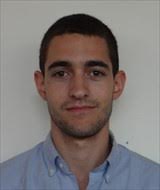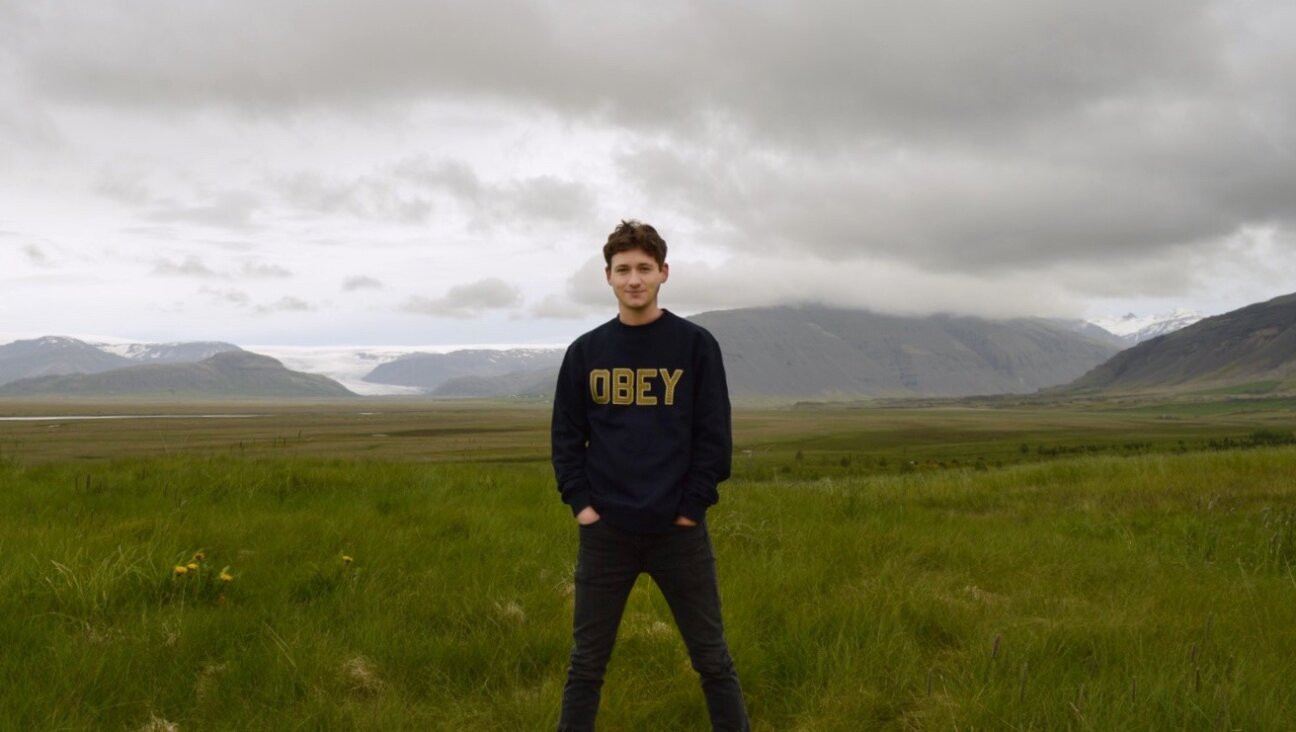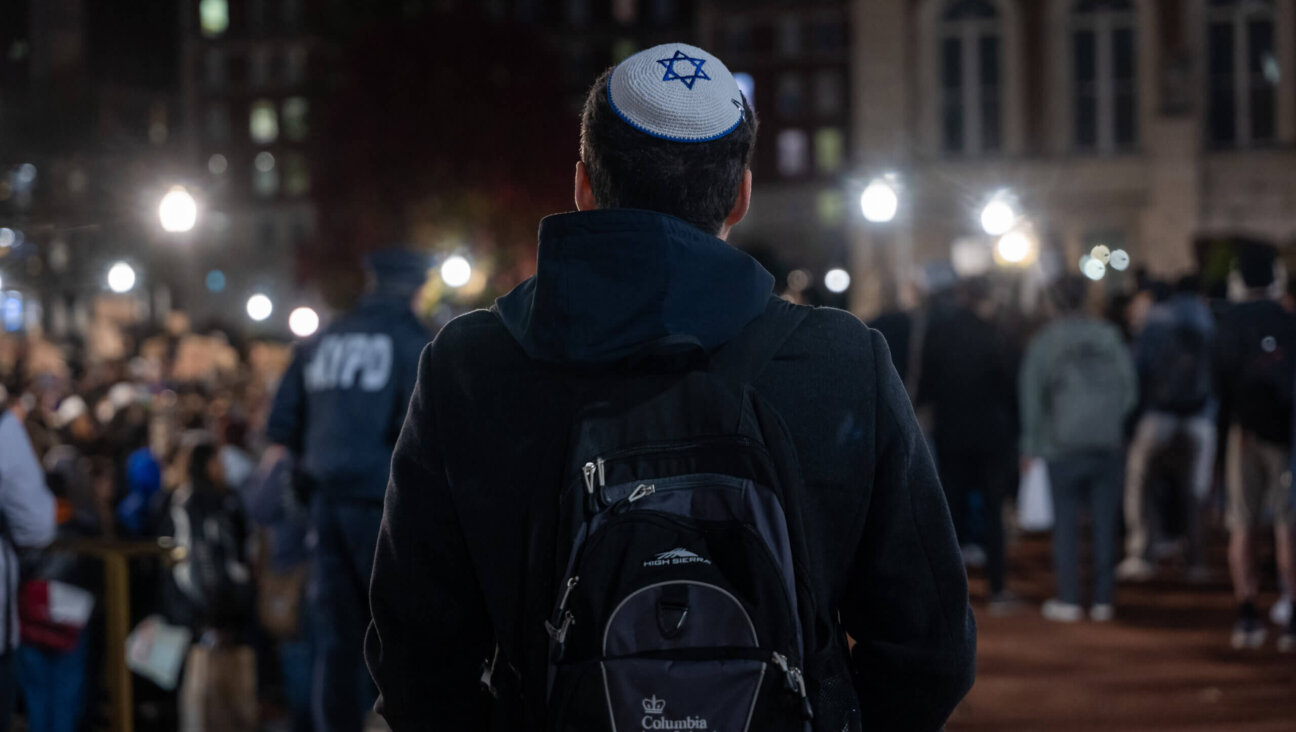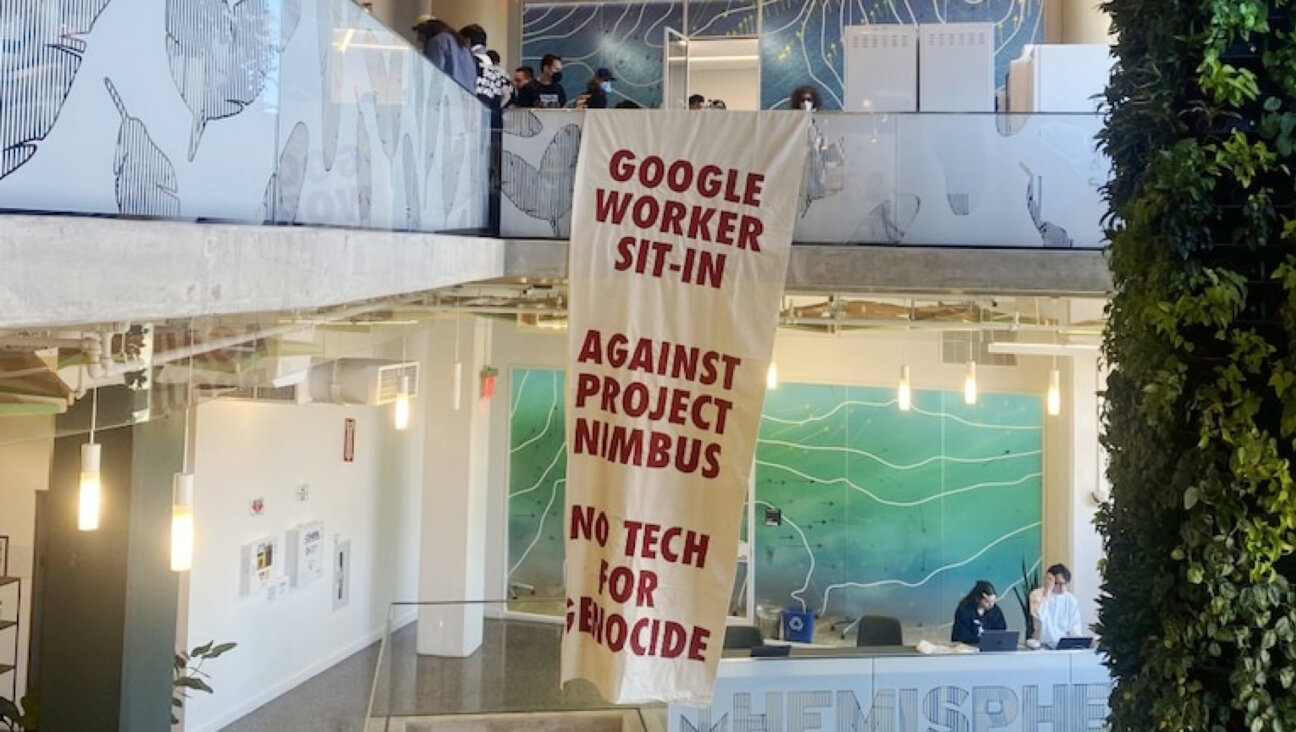A police crackdown in a Black neighborhood paved the way for a Jewish resurgence

Members of the Playboy Gangster Crips pose in the 1980’s Image by StreetTV.net
Editor’s note: In observance of Martin Luther King Jr. Day, the Forward is resurfacing some of our recent coverage related to the Black-Jewish experience and racial justice. This article originally appeared in July, 2020.
If you want to come to grips with the way race, injustice and real estate intertwine in America today, a good place to start is on Corning Street, a few hundred feet away from the 10 Freeway on the edge of the Westside of Los Angeles.
Corning Street looks and feels like it hasn’t changed since the 1950s. Boxy apartment buildings with names like Desert Sands. Humble Spanish-style bungalows with stained-glass bay windows. An alley behind them claimed as a pedestrian thoroughfare by working moms. A tamale cart, competing fruit stands, and an omnipresent produce truck that jingles “La Cucaracha” as it rounds the corner.

Fruit sellers, a tamale cart and a produce truck are part of La Cienega Heights life today. Image by Louis Keene
When I signed a lease on an apartment on Corning in 2018, I couldn’t believe my luck. The location couldn’t be beaten — 15 minutes from the beach, 20 from Downtown, a stone’s throw from Beverly Hills — yet I could afford it on a writer’s salary. Moreover, at a moment when I felt ambivalent about Orthodox Judaism, I could observe as I pleased. Most of the block’s residents were of Mexican descent, as was my new roommate, a stranger who had posted on Craigslist. But the neighborhood was adjacent to the heavily Orthodox Pico-Robertson area where I grew up, and I could walk to my parents’ for Shabbat dinner.
What I did not then understand was that the neighborhood, the very block, had changed a lot over the past 60-plus years. My good fortune had actually come at the tail end of a decades-long process of race-based discrimination. The Jewish revival of La Cienega Heights, as the neighborhood has been known since 2003, has not quite happened at the expense of Black life. But the trajectory of these 18 square blocks underscores the subtle ways in which American Jews, including myself, often benefit from structural anti-Black racism without realizing it.
First as vacant land not bound by race covenants, then as a pocket of affordable homes on the city’s upscale Westside, and now as an oasis of rent-controlled units near enough to synagogues and kosher restaurants, La Cienega Heights has always been a source of economic optimism for its residents.
But while it has served as a launchpad for upwardly mobile Jews and Latinos, the neighborhood was a spiteful trap for Blacks. In 1987, a policing experiment whose constitutionality has been challenged, the now-ubiquitous civil gang injunction, designated this neighborhood a “safety zone,” effectively making Black men subject to an oppressive regime within its boundaries. What lurks behind the buoyant, bustling community I joined two years ago is the legacy of that injunction, a signature tool of racial profiling and a singular menace to communities of color all over the country.
Jews from across the United States flocked to the area after the Great Depression, and over the following decades became filmmakers, real-estate developers, and business owners — the Westside’s upper-middle class. La Cienega Heights stayed predominantly white and Jewish through the 1950s.
Then, in 1967, came the first seeds of integration. That was the year the original cohort of Black students from South Los Angeles was bused to Alexander Hamilton High School, a mile from Corning Street. By 1972, half the school’s students were Black; by the 1980 census, 60% of La Cienega Heights residents were Black. Many of the area’s white residents, including most of its Jewish population, had moved out.
La Cienega Heights was not spared the introduction of rock cocaine into Black communities or the emergence of street gangs during the 1980s. Wrought-iron window bars and barbed wire went up around the neighborhood as a homegrown gang, the Playboy Gangster Crips, sold crack on Corning Street and controlled the surrounding blocks. The 1987 injunction developed to stop that gang, the first of its kind in the country, was the first of a series of crackdowns on crime in the neighborhood; what followed over the next 30 years was a gradual outflow of the neighborhood’s Black residents and an influx of Latino immigrants who took their place.
Today, but a fraction of the once majority-Black population remains in La Cienega Heights and Jews, pushed beyond the boundaries of Pico-Robertson by steep rents and a housing shortage, have begun to resettle there. The American Community Survey found that between 2014 and 2018, La Cienega Heights — the area bound by Robertson and La Cienega boulevards, between Sawyer Street and Cadillac Avenue, and to be clear, a place with no heights to speak of — is now roughly 20% Black and 50% Latino.
“I think what we’ve seen historically is arresting people and pushing people out does not create safety,” said Josh Green, an attorney who is director of criminal justice programs at the Urban Peace Institute. “At least not for the community that was there.”
The departure of Black residents from La Cienega Heights reflects a broader trend of Black migration out of L.A.’s core. But the suppressive policing strategy that originated here, as exemplified by injunctions, gang databases and sentencing enhancement, has also left a particular, indelible mark on this place. Barbed wire still wraps some fencing. Some alleys are still padlocked. Cops still patrol the one behind my apartment.

The Playboy Gangster Crips gang was founded in an alley near the corner of Corning St. and Cadillac Ave. Image by Louis Keene
The 1987 injunction started with a few dozen people, but its legacy includes the California gang database, which contains the names of nearly 80,000 state residents, most of them people of color, and many with no knowledge of their inclusion. On July 14, amid a growing scandal around false gang identifications by cops from the Los Angeles Police Department, state attorney general Xavier Becerra revoked access to CalGang records created by LAPD, essentially invalidating them. The decision, which affects about a quarter of the database, granted a victory that criminal-justice reform advocates had sought for decades. Meanwhile, La Cienega Heights has sprouted a kollel (an institution that supports full-time Torah scholars), more sukkahs crop up every fall, and I see as many yarmulkes as pet dogs on the walk to shul. The Black community does not seem likely to return to its previous numbers.
From Jewish to Black
Louis Thompson moved to Corning Street with his roommate in 1978 for the same reason Esperanza Ramirez did in 2001 and Gina Cardarella the year after that. “It was just about what I could afford,” Thompson, 82, said, speaking through the iron-grated front door of his Spanish-style house. (A pandemic was raging outside, and he was playing it safe.) Back then, Thompson recalled, the houses on Corning were mostly occupied by white Jewish homeowners, the apartment buildings by Black renters. But Thompson had a mortgage on the corner house.
If housing affordability is the story of post-redlining migration in Los Angeles, La Cienega Heights offers a fine case study. It took shape in the 1940s and 1950s, when an influx of upwardly mobile Jews from other L.A. neighborhoods and out of town moved into small houses on previously undeveloped parcels. Across the street from Thompson’s house, now the site of a shopping plaza with a Dollar Tree and a Coffee Bean, was a dairy farm.
In her 2015 book “Police, Power, and the Production of Racial Boundaries,” which contains a historical ethnography of La Cienega Heights, Ana Muñiz, a professor of criminology, law and society at the University of California-Irvine, writes that one resident estimated the neighborhood was 80% Jewish in the 1950s. As they found professional success, those Jews sent their children to Hamilton, one of the top public high schools in the city. They got zoning laws changed so they could put up apartments in their backyards.
Then came busing.
The desegregation of public schools after the landmark 1954 Supreme Court ruling in Brown v. Board of Education set in motion a demographic shift throughout the city. When a pilot program in the Los Angeles Unified School District designated 10 public high schools for voluntary busing in 1967, Hamilton enrolled 75 Black students. Soon, upwardly mobile Black families looking for housing on the Westside found the area around the school more affordable, especially La Cienega Heights, and moved here en masse. Thompson was one of them.
Six years after the pilot program began, Hamilton had 800 Black students, only 40 of whom were bused from outside the neighborhood.
Jewish groups — and Hamilton’s Jewish students — had supported desegregation, even joining a hunger strike with the Congress of Racial Equality outside a Board of Education meeting in 1963. But Jewish families fled La Cienega Heights to the adjacent Jewish neighborhoods following the high school’s integration. La Cienega Heights went from 98% white in 1970 to 25% white and 60% Black in 1980. The areas surrounding it — Beverlywood, Pico-Robertson, and Crestview — remained predominantly white, Jewish, and upper-middle-class, Muñiz writes, as La Cienega Heights “became an increasingly working-class, African-American island.”
Jews had not only left La Cienega Heights; they had also sold their buildings to property-management companies, which filled units with Section 8 tenants and lowered rents across the board. Toward the end of the decade, the passage of California Proposition 13, which froze property taxes at 1976 assessed values, throttled state and municipal revenue streams, causing a decline in public services and employment and pushing industries that employed working-class people out of state. The resulting collapse of opportunity, coupled with the introduction of crack cocaine into the inner city, fueled the rise of gang-related crime.
‘We need to abate the gang’
That’s when things got rough.
The Playboy Gangster Crips, a Black street gang, was born in 1979 in the alley behind my apartment, initially as a merger of rival break-dancing groups. As crack cocaine hit the drug market in the 1980s, the gang used Corning — nicknamed ‘C Street’ — to sell the drug, often to clients from the affluent, predominantly white adjacent areas. The distribution system involved pagers, hand signals, and lookouts posted on bicycles and perched on rooftops. When the cops showed up, the crews would disappear into the alleys to evade arrest.

Members of the Playboy Gangster Crips pose in the 1980’s Image by StreetTV.net
Thompson remembers teenagers from the gang dealing in broad daylight from beneath a tree on his front lawn. He never called the cops. “I guess, the fear,” he explained. Intimidation of residents was a major factor.
“Nobody could go outside, literally,” said Robert Ferber, a deputy city attorney at the time.
Ferber was tasked with stopping crime in La Cienega Heights in 1986, around the time Jeremy Steven Heading, a white 16-year-old, was killed on C Street in a drug deal gone wrong. The neighborhood, known back then as “Cadillac-Corning” for its most dangerous corner, was not the worst in Los Angeles at the time — violent-crime statistics were much higher in several pockets of South Central. But its proximity to white, upper-class areas garnered Cadillac-Corning special attention.
When Ferber first took the case, the gang, whose name was shorthanded as the PBGs, had taken over the neighborhood. A gas station on Cadillac and La Cienega was robbed so many times it closed. Landlords had ceased collecting rent entirely. Even police officers had to call into the station before driving down Corning. And while most of the drug trade occurred on C Street, home break-ins, car theft and muggings were commonplace on the surrounding blocks.
“This was a neighborhood version of organized crime,” Ferber recalled in a recent interview. At the same time, services were lacking — trash collection, he said, was erratic, the parks weren’t safe, and graffiti in public spaces seldom got painted over.

Gated alleys are the leftover legacy of law enforcement crackdown in Cadillac-Corning, including the country’s first gang injunction Image by Louis Keene
No matter how many gang leaders were thrown in jail, there was always another person ready to take their place. Ferber had faced a similar conundrum in the vice unit, where he was charged with cracking down on street prostitution. The only way he’d managed to make a dent was by filing nuisance abatements against the motels where sex workers brought clientele.
“We jokingly talked about, what we need to do is abate the gang,” Ferber said. “We ended up filing a lawsuit that was considered the wackiest thing in the court system.”
Ferber sued on behalf of community members, claiming the PBGs were a public nuisance and asking the court to stop the gang from doing things that helped it operate. People identified by residents and police as gang members (a dozen or so on the original list, which eventually grew to about 40) were summarily banned from a range of activities — carrying pagers, wearing blue, standing on rooftops, approaching vehicles, and congregating in public in groups of two or more.
Instead of handing out hefty sentences for dealing drugs, the longest jail sentence one could get for violating the injunction was five days, Ferber said. Still, if your name was on the list, you could go to jail for carrying a pager in Cadillac-Corning.
The American Civil Liberties Union challenged the injunction and won the removal of some terms, such as a curfew after 7 p.m. But Ferber’s project eventually made it through the courts, and later injunctions used the original as a template.
The early results surpassed the community’s wildest expectations. Gang members weren’t running from the cops — they were running from process servers, Ferber recalled. “We had literally pushed the gang out of the neighborhood,” he said. “They couldn’t get to the point of consummating a sale.” Ferber would tip off local stations before police roundups, and the injunction’s apparent success became a national news story. Los Angeles City Attorney James Hahn and Police Chief Daryl Gates rushed to expand its use.
But Ferber admitted the injunction failed to keep the crime or the gang out of Cadillac-Corning for long. A case-study available online shows another police crackdown on the Playboy Gangster Crips in the neighborhood beginning in 1997. Gina Cardarella said that when she moved to Corning Street in 2001, a driver delivering her pizza would not leave his car to drop off her order. Another resident recalled drive-by shootings on Corning in the same period.
According to Green, the Urban Peace Institute attorney, gang injunctions failed to stop crime because they punished symptoms of disenfranchisement rather than address them. “The root causes of the violence were not that law enforcement didn’t have enough weapons or tools at its disposal,” he said. “The root causes were the disinvestment from the communities.”
‘A Terrifying Tool For Abuse’
The Cadillac-Corning injunction, the first served to an entire gang, opened a Pandora’s box of surveillance, policing, and criminalization. Injunctions were spirited through courts, and became bigger, broader, and more punitive. The Cadillac-Corning injunction spanned 26 square blocks. A 2011 injunction east of Downtown Los Angeles spanned 16 square miles — more than 60 times the size of the original. Whereas residents worked with law enforcement to identify the gang members on Ferber’s injunction, later injunctions listed John Does, enabling cops to decide afterward who warranted the restrictions. From 2000 to 2018, the city of L.A. added 8,900 people from 79 gangs to injunctions, according to the city attorney’s office.
Gang injunctions have been used almost exclusively in neighborhoods whose populations are overwhelmingly nonwhite. And while these injunctions never discuss race explicitly, “the actual application of the document is clearly racialized,” said Green.
Injunctions have offered a pretext for thousands of Black men to be added to the CalGang database without knowing it and with little recourse. Factor in laws that escalate penalties for identified gang members, and a regime aimed at crime suppression has been a potent accelerant of mass incarceration. The American prison system now has more than 2 million Black people behind bars.
Ferber, who left the gang unit in 1993, defended his injunction’s intent. But he worried as he saw it sweep the nation. “I started to see, anybody who is walking with a gang member is now a gang member,” he said. “I thought, ‘My baby is turning into a terrible tool for abuse.’”
The Black residents of La Cienega Heights attest to that abuse. Esperanza Ramirez, who raised two Black sons on Corning Street after moving there in 2001, does not live in fear of gang violence. But she does not live in peace, either. She described her eldest, Donovan, being thrown against a wall and searched by police officers on their street a few years ago. More recently Benjamin, her teenager, was detained for jaywalking on his way out of basketball practice.
Crime in the neighborhood has diminished in recent years, she said, but zealous policing has not. “If you have a kid who’s a minority, that trauma doesn’t go away,” Ramirez said. “Your mind can’t relax because you always have that worry. It’s like, ‘When am I going to be happy?’”
Home sweet home, for some
There’s a way in which the Latino spirit of La Cienega Heights can give it the feeling of an old Jewish shtetl: the melody of everyday life, the primacy of walking; front-yard birthday parties, kids chasing the ice-cream truck. The pushcart, a bygone symbol of Jewish hustle, now represents entrepreneurship for immigrant Angelenos; in La Cienega Heights, they dish out elotes, tamales, and snow cones. But it seems like only a matter of time before this place stops feeling like an old Jewish shtetl and starts feeling like a new one.
Corning Street got its first luxury housing this year, on the same corner where Jeremy Steven Heading was shot in 1986. A few blocks west, but still in the neighborhood boundaries, luxury condos rent for $9,500 a month. The kollel’s resident scholars have moved into an older building a block over. One real-estate agent told me he expects most of the neighborhood to flip Jewish in the next decade. Only rent control on these old apartment buildings will make it take that long.
So for the moment it remains predominantly Latino, reflecting a decades-long trend of L.A.’s Black neighborhoods turning brown. Latinos — many of them immigrants — now make up the overwhelming majority of residents in South Los Angeles, the historic core of Black life in Southern California, and about half of the population of La Cienega Heights. Blacks, seeking areas with lower crime and more affordable housing, have spread to outer suburbs like Palmdale and Lancaster, some 40 miles from the city center.
But while Latinos can still feel the brunt of aggressive policing, most Jewish people could move to an area under a gang injunction and never be the wiser. In the case of La Cienega Heights, they can rush out of a neighborhood when Blacks move in and trickle back after Black residents are pushed or priced out. Where a gang injunction criminalizes geography for people of color, it does just the opposite for whites, enhancing their mobility, enabling them to move into new neighborhoods. And in my neighborhood today, Jews are among the beneficiaries.

From Cadillac-Corning to La Cienega Heights: A luxury apartment building rises between two mid-century buildings Image by Louis Keene
While there is no longer a gang injunction over La Cienega Heights, scores of injunctions remain across Los Angeles County, elsewhere in California, and in communities of color all over the United States. The shadow of oppressive policing that stretches from this neighborhood is impossible to measure.
Being white and Jewish in La Cienega Heights means that shadow will never affect me. It means that I’ll never be stalked by a patrol car, or asked to show my ID going from a walk at night. It means I can ride a bike, or stand on a roof, or hang with my friends without drawing suspicion. My presence in this neighborhood won’t make adjacent areas uncomfortable. Nearly two years into living here, Corning Street feels like home. I banter with the driver as I buy produce from the La Cucaracha truck. An old shul nearby is experiencing a revival, and new kosher restaurants have opened alongside it.
But I think I will struggle with the history of the place as long as I live here. Every time a new family moves in — presumably for the same reason Louis Thompson did in 1978, the same reason I did in 2018 — it will be coasting on those errant facts of life, almost certainly without knowing it. A woman will cry tamale into the twilight air. Teenagers headed to after-school jobs will bike down the alleys. And when they no longer do, I’ll know it’s time for me to leave.

I hope you appreciated this article. Before you go, I’d like to ask you to please support the Forward’s award-winning journalism this Passover.
In this age of misinformation, our work is needed like never before. We report on the news that matters most to American Jews, driven by truth, not ideology.
At a time when newsrooms are closing or cutting back, the Forward has removed its paywall. That means for the first time in our 126-year history, Forward journalism is free to everyone, everywhere. With an ongoing war, rising antisemitism, and a flood of disinformation that may affect the upcoming election, we believe that free and open access to Jewish journalism is imperative.
Readers like you make it all possible. Right now, we’re in the middle of our Passover Pledge Drive and we need 500 people to step up and make a gift to sustain our trustworthy, independent journalism.
Make a gift of any size and become a Forward member today. You’ll support our mission to tell the American Jewish story fully and fairly.
— Rachel Fishman Feddersen, Publisher and CEO
Join our mission to tell the Jewish story fully and fairly.
Our Goal: 500 gifts during our Passover Pledge Drive!
























